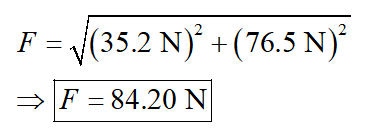the following example is given: vector1 =+(60.0N)i+(103.9N)j vector2 =+(75.2N)i−(27.4N)j vector 3=−(100.0N)i+(0.0N)j vecor net =+(35.2N)i+(76.5N)j Convert this net force to polar coordinates; that is, find the total vector magnitude and angle.
the following example is given:
vector1 =+(60.0N)i+(103.9N)j
vector2 =+(75.2N)i−(27.4N)j
vector 3=−(100.0N)i+(0.0N)j
vecor net =+(35.2N)i+(76.5N)j
Convert this net force to polar coordinates; that is, find the total vector magnitude and angle.
If three forces, 1 , 2 , and 3 , are in equilibrium, what is the relationship between the sum of the first two forces and the third force? Write your answer as an equation.
onsider the vector = −(51.7 N)i + (63.9 N)j
-
(a) Convert this value to polar coordinates (magnitude and angle).
-
(b) When converting this to polar coordinates, what answer does your calculator give
you for the angle of the vector? Explain whether this is correct or not (including the correct angle if applicable).
STEP 1:
Hello. Since you have posted multiple questions and not specified which question needs to be solved, we will solve the first question for you. If you want any other specific question to be solved then please resubmit only that question or specify the question number.
1)
The net force is given as,

The net force’s magnitude can be determined as,

Here, Fx and Fy represent the net force’s X and Y components, respectively.
Substitute the relevant values.

Trending now
This is a popular solution!
Step by step
Solved in 2 steps with 5 images









